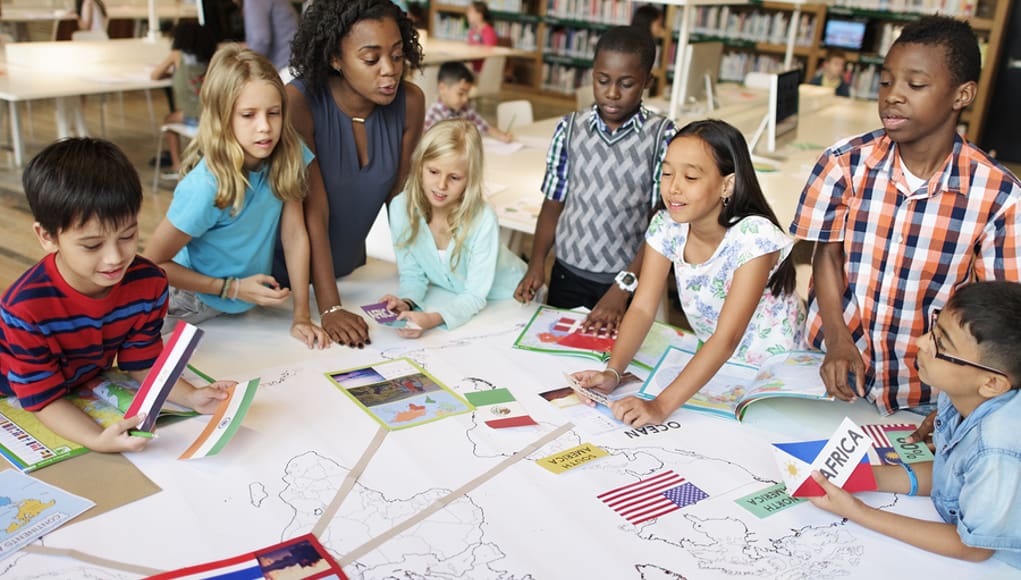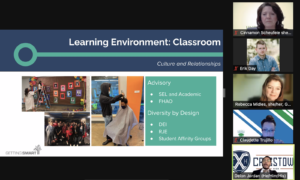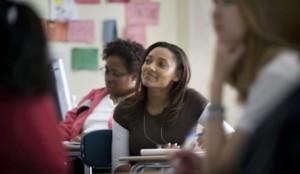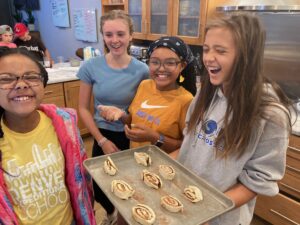3 Visions of Truly Inclusive Education

By Jennifer D. Goldman, Karyn Lewis and Dr. Genevra Walters
In their mission to prepare every student for college or a career, today’s K-12 schools have to support not just high achievers, but students with emotional disturbances, language issues and hearing challenges. Here are three educators whose creative solutions are making “readiness for all” a reality.
How a Makerspace Fosters a Culture of Inclusivity
Jennifer D. Goldman, Principal
Our school caters to a lot of students from nontraditional backgrounds, and we have programs geared toward students with autism, emotional disturbances and hearing loss. Finding ways to engage every student and create a culture of inclusivity is very high on our list of priorities. When we were retooling our vision, we worked under the theme of “A bright future starts with an IDEA,” where “IDEA” stands for Interactive technology, Digital discovery, Exploration and Awareness (or inclusivity, if you like). We asked teachers to consider these themes, but we were also on the hunt for a way to show them off schoolwide.
Since I’m an administrator, I felt like my job was to hand over the reins to the librarians and teachers who had all the ideas about what this would look like in practice. When they suggested devoting half of our library to a makerspace I didn’t bat an eye. When wanted to clear out a storage room and turned it into a green screen animation center, I told them to go for it.
At first, we didn’t have a lot of stuff to fill our makerspace, so we added comfortable seating and made it a place where kids would want to spend time. In a school where students have so many different learning preferences, strengths and weaknesses, a makerspace lends itself beautifully to shared learning, exploration, novel engineering and working with multiple modalities.
Slowly, though, we began adding things: tinker tables, sewing machines, coding toys, tablets, computers with animation software and more. We sent home a “wish list” to parents asking for donations, and they came through in ways I had never even hoped for, crowding our tables with fabrics, craft supplies and Legos.
I also approached vendors and offered to pilot new products whenever I could. To make sure all of our students were getting the most out of the experience, I had the idea to add a central speaker system to the room. Many of the deaf and hard-of-hearing students carried around personal amplification systems, but we wanted something that every student and teacher could be a part of. We added a microphone and ceiling-mounted Topcat amplification system from Lightspeed Technologies, which students use to present their work. And we learned how much more confident students (and teachers) are when they don’t have to shout.
Before we created our makerspace, students had regularly scheduled library time with their classes. Now, we’ve split that time in half, giving students some time in the library as well as the makerspace. We also open it up during lunchtime and recess for free exploration. When teachers assign open-ended projects, students often come into the makerspace and start creating. In that way, it’s become a fluid space that’s both a part of and separate from the classroom.
Using Music to Bridge the Language Gap
Karyn Lewis, Pre-K–5 Librarian
When working with toddlers during a weekly story time I held for the community at my school library, I often came across barriers such as language and cultural differences. Many of these children were shy English language learners (ELLs). It was during these story times that I discovered the magic of music to bridge the language gap. The songs I played would instantly perk these kids up and get their attention. Students are naturally motivated by music, so they couldn’t help but sing, clap and dance along to the many books we read together.
When putting together a summer school lesson plan for my pre-K ELLs, I turned to the Cantata Learning books, which include songs and rhymes that make reading fun and easy for a wide variety of students. There are many great books about science and history concepts, including famous scientists, the water cycle and the planets. I used the books with my pre-K and kindergarten ELLs once a week to work to help build their vocabulary and a love of books reading.
Through the songs, pictures and movements, the students were quickly able to make connections to the content in each book, which helped them learn and remember the words at an accelerated rate. The more engaged students can be during the reading of the book and song the better, so we would often stand up, dance, and make up motions for the songs together. This process involves several of the learning modalities (audio, visual and kinesthetic) and therefore helps students have multiple ways to access the information later.
I remember the book “Head, Shoulders, Knees and Toes” being especially engaging for the students, and it was a lesson the teachers also enjoyed. I started the lesson by asking students to point to their head, shoulders, knees and toes—at this point in the lesson, many students needed a teacher assisting them in Spanish to do.
As I played the song, the students stood up and followed the directions to touch the different parts of their body, mirroring my movements. When the song finished, we listened to it one more time. This time, the students were singing the new English words and confidently pointing to the body parts as the song played. At the end of the lesson I asked them to find the new parts of their body mentioned in the book, and they were able to find them and point to them easily.
The music and rhymes make learning fun for the ELL students. Students loved them so much that they asked me to play the songs again and again.
Preparing Preschoolers for Careers
Dr. Genevra Walters, Superintendent
Since I started in education, I’ve used the motto, “The transition to adulthood starts in preschool.” It’s the idea that conversations about college and careers need to start earlier rather than later. Today, that phrase is the mantra that fuels my teachers and principals to think past the traditional style of teaching, and to truly prepare our students for life outside the four walls of a school building by giving them hands-on experience and the chance to explore a plethora of careers through project-based learning.
In the College and Career Academy classrooms in our elementary school, each grade focuses on a different range of careers, so as students move through school they have a chance to explore a variety of fields and decide where their interests lie. For example, first-graders focus on careers in agriculture, food and natural resources; while third-grade students focus on engineering, outer space and plant life. The idea is for students’ knowledge of and interest in different career fields to evolve as they progress through elementary school.
During the school year, students undertake four large-scale projects that align with their grade-level focus and appropriate state standards. We use supplementary curriculum from Defined STEM, which breaks down tasks by grade level and keeps all lesson materials such as articles, videos and rubrics in one spot. The projects give students room for individual creativity as they master career skills including problem-solving and collaboration.
The hands-on projects make the careers come alive, because students can apply their classroom knowledge to the real world. During the projects, students are asked to think like engineers, designers, doctors or whatever position is relevant to the task. This change of mindset engages students because they’re using their creativity and critical thinking skills to solve a problem. They’re not memorizing facts for a test; they’re applying what they’ve learned and demonstrating their skills to create an end product such as a 3D model, presentation, etc. When these career projects are incorporated into relevant teacher lessons, students are pushed to think towards the future and determine what they want to be when they grow up.
For more, see:
- Early Learning as a Strategy for Achieving Equity
- Closing the Last Mile of Career Opportunity in Rural America
- Equity for English Language Learners: Quality Two-Way Immersion
Jennifer D. Goldman is principal at Mountain View Elementary in Simi Valley, CA. Follow her on Twitter: @jennydgoldman.
Karyn Lewis is a pre-K–5 librarian at Meadow Wood Elementary in Texas. Follow her on Twitter: @ktlewis14.
Dr. Genevra Walters is the superintendent of schools at Kankakee School District in Illinois. Follow her on Twitter: @walters_genevra.
Stay in-the-know with all things EdTech and innovations in learning by signing up to receive the weekly Smart Update.







0 Comments
Leave a Comment
Your email address will not be published. All fields are required.